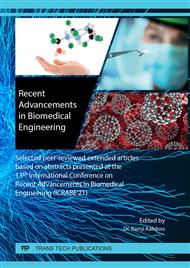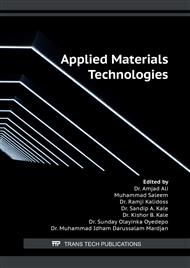[1]
A. Lee, J. Chin, O.K. Park, H. Chung, J.W. Kim, S.-Y. Yoon and K. Park, A novel near-infrared fluorescence chemosensor for copper ion detection using click ligation and energy transfer, Chem. Commun., 49, (2013), p.5969.
DOI: 10.1039/c3cc42059k
Google Scholar
[2]
R. Zhou, B. Li, N. Wu, G. Gao, J. You, and J. Lan, Cyclen-functionalized perylenebisimides as sensitive and selective fluorescent sensors for Pb2+ in aqueous solution, Chem. Commun., 47, (2011), p.6668–6670.
DOI: 10.1039/c1cc11200g
Google Scholar
[3]
K. Radhakrishanan, P. S. Kumar. Target-receptive structural switching of ssDNA as selective and sensitive biosensor for subsequent detection of toxic Pb2+ and organophosphorus pesticide. Chemosphere, 287(2021) 132163.
DOI: 10.1016/j.chemosphere.2021.132163
Google Scholar
[4]
A. Barba-Bon, A.M. Costero, S. Gil, M. Parra, J. Soto, R. Martınez-Manez and F. Sancenon, A new selective fluorogenic probe for trivalent cations, Chem. Commun., 48, (2012), p.3000–3002.
DOI: 10.1039/c2cc17184h
Google Scholar
[5]
J. Wang, Y. Li, N.G Patel, G. Zhang, D. Zhoub and Y. Pang, A single molecular probe for multi-analyte (Cr3+, Al3+ and Fe3+) detection in aqueous medium and its biological application, Chem. Commun., 50,(2014), pp.12258-12261.
DOI: 10.1039/c4cc04731a
Google Scholar
[6]
J. Liang, M. Qin, R. Xu, X. Gao, Y. Shen, Q. Xu, Y. Cao and W. Wang, A genetically encoded copper (I) sensor based on engineered structural distortion of EGFP, Chem. Commun., 48, (2012), p.3890–3892.
DOI: 10.1039/c2cc30531c
Google Scholar
[7]
B. Wu, L. Xu, S. Wang, Y. Wang and W. Zhang, A PEGylated colorimetric and turn-on fluorescent sensor based on BODIPY for Hg (II) detection in water, Polym. Chem., 6(2015), pp.4279-4289.
DOI: 10.1039/c5py00390c
Google Scholar
[8]
T. Lan, K. Furuya and Y. Lu, A highly selective lead sensor based on a classic lead DNAzyme, Chem. Commun., 46 , (1210), pp.3896-3898.
DOI: 10.1039/b926910j
Google Scholar
[9]
F. Salimi, M. Kiani, C. Karami, M. AliTaher, Colorimetric sensor of detection of Cr (III) and Fe (II) ions in aqueous solutions using gold nanoparticles modified with methylene blue, OPtik. 158, (2018), pp.813-825.
DOI: 10.1016/j.ijleo.2018.01.006
Google Scholar
[10]
M. Ismail, M.I. khan, M. Alikhan, A. M. Asiri, and S. Bahadarkhan, Biosynthesis of silver nanoparticles for detection of hexavalent chromium and ammonia in aqueous solution, Physica E: Loe-dimensional Systems and Nanostructures, 103, (2018), pp.367-376.
DOI: 10.1016/j.physe.2018.06.015
Google Scholar
[11]
F. Sang, X. Li, Z. Zhang, J. Liu, and G. Chen, Recyclable colorimetric sensor of Cr3+ and Pb2+ ions simultaneously using a zwitterinic amino acid modified gold nanoparticles, Spectochimica Acta Part A: Molecular Spectroscopy. 193, (2017), pp.109-116.
DOI: 10.1016/j.saa.2017.11.048
Google Scholar
[12]
Y. Choi, Y. Park, T. Kang, and L.P. Lee, Selective and sensitive detection of metal ions by plasmonic resonance energy transfer-based nano-spectroscopy, Nature Nanotechnology, 4, (2009), pp.742-746.
DOI: 10.1038/nnano.2009.258
Google Scholar
[13]
K. Radhakrishanan, P. Panneerselvam, and S. Sivanesan, Fluorescence switching of green synthesized carbon dots@ g-C3N4nanosheet as a label-free sensor for detection of multiple metal ions," J PhotochemPhotobiol A.,389 (2020) 112204-112215.
Google Scholar
[14]
B-F.Ye, Y-J. Zhao, Y. Chen, T-T. Li, Z-Y. Xie, X-W. Zhao, and Z-Z. Gu, Colorimetric photonic hydrogel aptasensor for the screening of heavy metal ions, Nanoscale. 4, (2012), pp.5998-6003.
DOI: 10.1039/c2nr31601c
Google Scholar
[15]
C. Hao., L. Xua., C. Xing., H. Kuang., L. Wang., C. Xu., Oligonucleotide-based Fluorogenic sensor for simultaneous detection of heavy metal ions, Biosensors and Bioelecronics, 36, (2012), pp.174-178.
DOI: 10.1016/j.bios.2012.04.008
Google Scholar
[16]
S. Su, B. Chen.,M. He., B. Hu., Graphene oxide-silica composite coating hollow fiber solid phase microextraction online coupled with inductively coupled plasma mass spectrometry for the determination of trace heavy metals in environmental water samples, Talanta. 123, (2014), pp.1-9.
DOI: 10.1016/j.talanta.2014.01.061
Google Scholar
[17]
M. Mizaei., M. Behzadi., N. M. Abadi., A. Beizaei, Simultaneous sepration/ preconcentration of ultra trace heavy metals in industrial wastewaters by dispersive liguid-liquid microextaction based on solidification of floating organic drop prior to determination by graphite furnace atomic absorption spectrometry, Journal of Hazardous Materials.186, (2011), pp.1739-1743.
DOI: 10.1016/j.jhazmat.2010.12.080
Google Scholar



